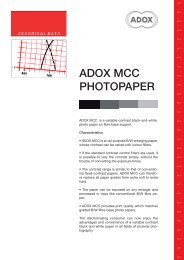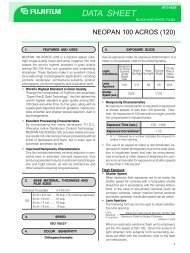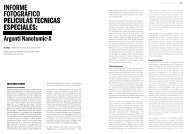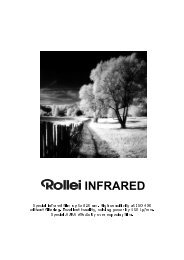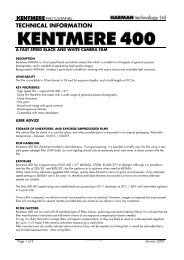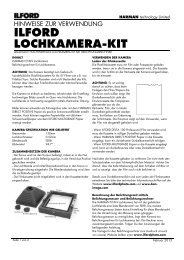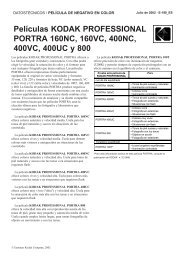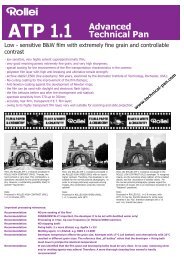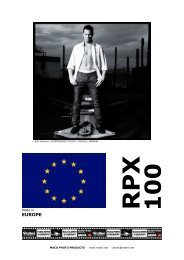Technical Data Agfa Professional Films - AgfaPhoto
Technical Data Agfa Professional Films - AgfaPhoto
Technical Data Agfa Professional Films - AgfaPhoto
Create successful ePaper yourself
Turn your PDF publications into a flip-book with our unique Google optimized e-Paper software.
Directions for X-ray inspectionsThe basic rule is that films are sensitive to X-rays, and this sensitivityincreases with the film’s sensitivity. The X-ray inspection equipmentused on many airports marked “Film Safe” does not affect filmsunder normal circumstances. Nevertheless, for safety’s sake filmsshould not be handed in as luggage but kept in hand luggage. Incases of doubt a visual inspection is preferable.ProcessingFilm type Process Compatible Processwith process data sheet<strong>Agfa</strong>color AP 70 C-41 C-70,negative films C-7172<strong>Agfa</strong>chrome AP 44 E-6 C-44slide films<strong>Agfa</strong>pan For developing methods, types C-SW16B/W filmsetc. see data sheet<strong>Agfa</strong> Scala 200x Special Scala process in authorisedB/W slide film Scala labs only (see internet: www.agfa.com)The <strong>Technical</strong> <strong>Data</strong> sheets listed contain detailed informationon the processing of the relevant films.Pushed/pulled processing of slide filmsIf the first development time is changed, the photographic speedalso changes. Lengthening the time leads to an increase in speed(so-called pushing), shortening the time reduces it (pulling).This is a correction method often used in professional photography,with the aim of a fine adjustment of the colour densityor a deliberate change in speed.The <strong>Agfa</strong>chrome RSX II <strong>Professional</strong> films feature exceptio-nallygood push/pull stability. Up to a speed adjustment of ± 1 stop(1), the neutrality of colour rendition is preserved in full. Evenan increase in speed of up to two stops only has a very slighteffect on the colour balance.<strong>Agfa</strong> Scala 200x <strong>Professional</strong>With the standard Scala process: ISO 200/24°.The speed of the <strong>Agfa</strong> Scala 200x can be varied in steps by pushing orpulling the process. The contrast, maximum density and granularitysimultaneously vary in comparison to the standard process.Step Push 1 Push 2 Push 3 Pull 1Speed (ISO) 400/27° 800/30° 1600/33° 100/21°Contrast increasingly steeper flatterMaximum density decreasing increasingGranularity increasingly coarse-grained finerApplicationsVarying the speed and the contrast is useful in many fields.Pushed processinga) To increase the speed:– with poor lighting / available light– with lenses with long focal lengths and / or low power– with fast-moving subjectsb) To steepen the contrast:– for dramatic effectsPulled processinga) To decrease the speed:– for higher maximum density– for finer granularity (–10 % at ISO 100/21°)b) To flatten the contrast:– for reproductions of X-rays– for duplicates of BW negatives and original ScalatransparenciesStorage of processed filmsThe same precautions apply to processed films:• under 25° C• 30 to 60 % relative humidity• protected from fumes• darknessFurther processingEvaluating negativesNegatives of colour and black and white films can be appraisedin basically the same way. The most important criterion is theshadow area. Thin coverage in comparison to the mask colorationshould be apparent on colour negatives.RetouchingIn portrait photography and in some other areas as well, theretouching of processed film material is common. The film typessuitable for this treatment incorporate a retouchable back (onlyroll film and sheet film), i.e. they are suitable for pencil and liquidretouching (retouching paints). Only the <strong>Agfa</strong>color XPS 160 rollfilm has a retouchable emulsion.Evaluating slidesThe colour balance of <strong>Agfa</strong>chrome <strong>Professional</strong> films is designedfor the viewing light specified in ISO 3664. The main features ofthis standard:• colour temperature 5000 K• mean luminance 1400 cd/m 2• uniformity of luminance at least 75 %Comparisons should be made in principle on one and the samelight box, because there may be considerable variations in lightcolour and intensity between different boxes.Use of slide films in scannersAll <strong>Agfa</strong>chrome <strong>Professional</strong> films are reprographically compatible.The high-grade photographic characteristics of this materialare therefore transferred completely, even if only the standardscanner setting is used.4 F-PF-E3



